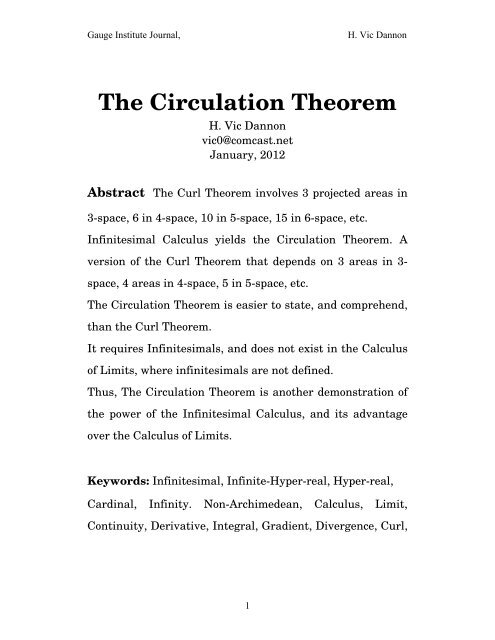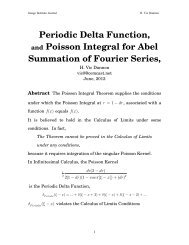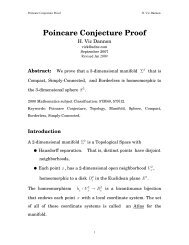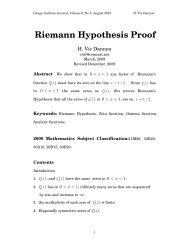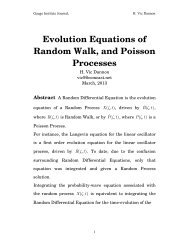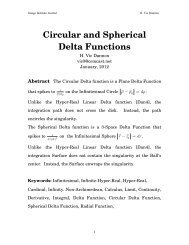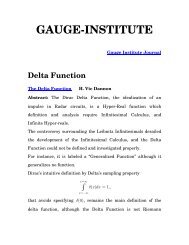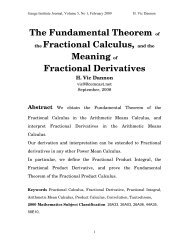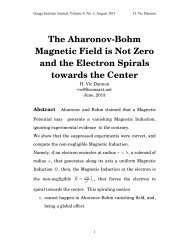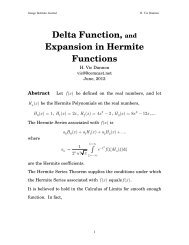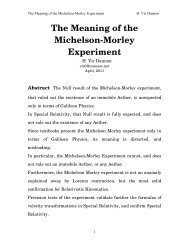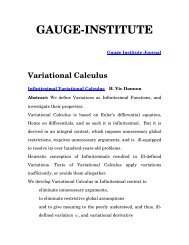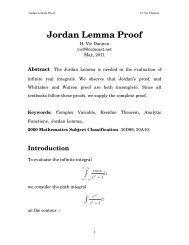The Infinitesimal Circulation Theorem - Gauge-institute.org
The Infinitesimal Circulation Theorem - Gauge-institute.org
The Infinitesimal Circulation Theorem - Gauge-institute.org
You also want an ePaper? Increase the reach of your titles
YUMPU automatically turns print PDFs into web optimized ePapers that Google loves.
<strong>Gauge</strong> Institute Journal,<br />
H. Vic Dannon<br />
<strong>The</strong> <strong>Circulation</strong> <strong>The</strong>orem<br />
H. Vic Dannon<br />
vic0@comcast.net<br />
January, 2012<br />
Abstract <strong>The</strong> Curl <strong>The</strong>orem involves 3 projected areas in<br />
3-space, 6 in 4-space, 10 in 5-space, 15 in 6-space, etc.<br />
<strong>Infinitesimal</strong> Calculus yields the <strong>Circulation</strong> <strong>The</strong>orem. A<br />
version of the Curl <strong>The</strong>orem that depends on 3 areas in 3-<br />
space, 4 areas in 4-space, 5 in 5-space, etc.<br />
<strong>The</strong> <strong>Circulation</strong> <strong>The</strong>orem is easier to state, and comprehend,<br />
than the Curl <strong>The</strong>orem.<br />
It requires <strong>Infinitesimal</strong>s, and does not exist in the Calculus<br />
of Limits, where infinitesimals are not defined.<br />
Thus, <strong>The</strong> <strong>Circulation</strong> <strong>The</strong>orem is another demonstration of<br />
the power of the <strong>Infinitesimal</strong> Calculus, and its advantage<br />
over the Calculus of Limits.<br />
Keywords: <strong>Infinitesimal</strong>, Infinite-Hyper-real, Hyper-real,<br />
Cardinal, Infinity. Non-Archimedean, Calculus, Limit,<br />
Continuity, Derivative, Integral, Gradient, Divergence, Curl,<br />
1
<strong>Gauge</strong> Institute Journal,<br />
H. Vic Dannon<br />
2000 Mathematics Subject Classification 26E35; 26E30;<br />
26E15; 26E20; 26A06; 26A12; 03E10; 03E55; 03E17;<br />
03H15;46S20; 97I40; 97I30.<br />
2
<strong>Gauge</strong> Institute Journal,<br />
H. Vic Dannon<br />
Introduction<br />
<strong>The</strong> Curl <strong>The</strong>orem over an infinitesimal rectangle in the<br />
Plane says that the circulation of ⎡Pxy<br />
(, ), Qxy (, ) ⎤<br />
⎢⎣<br />
⎥ around the<br />
⎦<br />
rectangle depends on one area<br />
∫<br />
infinitesimal<br />
rectangle<br />
∂x<br />
∂y<br />
P(, x y) dx + Q(, x y)<br />
dy = dxdy<br />
P Q<br />
<strong>The</strong> Curl <strong>The</strong>orem Over an infinitesimal 3-box says that the<br />
circulation of ⎡Pxyz (,, ), Qxyz (,, ), Rxyz (,, ) ⎤<br />
⎢⎣<br />
⎥⎦<br />
sides of the 3-box depends on 3 areas.<br />
around the<br />
∫ Pxyzdx (,, ) + Qxyzdy (,, ) + Rxyzdz (,, ) =<br />
sides of<br />
infinitesimal 3-box<br />
∂x ∂y ∂z ∂x ∂y ∂z<br />
= dxdy + dzdx + dydz<br />
P Q R Q Q R<br />
<strong>The</strong> Curl <strong>The</strong>orem Over an infinitesimal 4-box says that the<br />
circulation of<br />
⎡Pxyzt (,,,), Qxyzt (,,,), Rxyzt (,,,), Sxyzt (,,,) ⎤<br />
⎢⎣<br />
⎥⎦<br />
around the sides of the 3-box rectangle depend on 6 areas.<br />
∫ Pxyztdx (,,,) + Qxyztdy (,,,) + Rxyztdz (,,,) + Sxyztdt (,,,) =<br />
sides of<br />
infinitesimal 4-box<br />
3
<strong>Gauge</strong> Institute Journal,<br />
H. Vic Dannon<br />
∂z ∂t ∂t ∂x ∂x ∂z<br />
= dzdt + dtdx + dxdz +<br />
R S S P P R<br />
∂x ∂y ∂t ∂y ∂y ∂z<br />
+ dxdy + dtdy + dydz<br />
P Q S Q Q R<br />
<strong>The</strong> Curl <strong>The</strong>orem Over an infinitesimal 5-box says that the<br />
circulation of<br />
⎡Pxyztu (,,,, ), Qxyztu (,,,, ), Rxyztu (,,,, ), Sxyztu (,,,, ), Txyztu (,,,, ) ⎤<br />
⎢⎣<br />
⎥⎦<br />
around the sides of the 5-box rectangle depends on 10 areas.<br />
<strong>The</strong> number of different areas is the number of combinations<br />
of pairs in the space,<br />
⎛2⎞ ⎜<br />
=<br />
2<br />
⎜⎝ ⎠ ⎟<br />
⎛3⎞ 1, ⎛ 4⎞ = 3, ⎛ 5<br />
⎜<br />
, , ,…<br />
2<br />
= 6<br />
⎞ ⎛ 6⎞ ⎜⎝ ⎠ ⎟ ⎜2<br />
= 10<br />
⎜⎝ ⎠ ⎟ ⎜2<br />
15<br />
⎜⎝ ⎟ ⎜<br />
=<br />
⎠ 2<br />
⎜⎝ ⎟ ⎠<br />
<strong>The</strong> false belief that the 6 areas in 4-space are all<br />
independent, lead to the definition of a 6 dimensional Curl in<br />
4-space. But as we pointed out in [Dan4], the 4-space Curl is<br />
4 dimensional.<br />
While the number of circulation terms in the Curl <strong>The</strong>orem<br />
equals the space dimension, the number of areas depends on<br />
the space dimension indirectly.<br />
Here, we seek, and obtain a <strong>Circulation</strong> <strong>The</strong>orem in which<br />
the number of areas involved is the dimension of the space.<br />
4
<strong>Gauge</strong> Institute Journal,<br />
H. Vic Dannon<br />
<strong>The</strong> <strong>Circulation</strong> <strong>The</strong>orem is easier to state, and comprehend,<br />
than the Curl <strong>The</strong>orem.<br />
For space dimension greater than 3, the <strong>Circulation</strong><br />
<strong>The</strong>orem holds, while the Curl <strong>The</strong>orem holds only if one<br />
accepts an erroneous definition of the Curl.<br />
For instance, in 4 dimensions the Curl is 4 dimensional, and<br />
not 6-dimensional<br />
<strong>The</strong> derivation, and the statement of the <strong>Circulation</strong><br />
<strong>The</strong>orem requires <strong>Infinitesimal</strong>s.<br />
Consequently, the <strong>Circulation</strong> <strong>The</strong>orem does not exist in the<br />
Calculus of Limits, where infinitesimals are not defined.<br />
Thus, the <strong>Circulation</strong> <strong>The</strong>orem is another demonstration of<br />
the power of the <strong>Infinitesimal</strong> Calculus, and its advantage<br />
over the Calculus of Limits.<br />
We need to use <strong>Infinitesimal</strong>s, <strong>Infinitesimal</strong> Calculus, and<br />
<strong>Infinitesimal</strong> Vector Calculus.<br />
We have constructed infinitesimals in [Dan1], established<br />
the <strong>Infinitesimal</strong> Calculus in [Dan2], and derived the<br />
<strong>Infinitesimal</strong> Vector Calculus in [Dan3]. <strong>The</strong> Hyper-real<br />
Plane, Hyper-real Vector Functions, Continuity, Derivatives,<br />
and Hyper-real Integration are presented in [Dan3].<br />
5
<strong>Gauge</strong> Institute Journal,<br />
H. Vic Dannon<br />
1.<br />
Hyper-real Plane<br />
We present the Hyper-real 2-Space, which is a cross product<br />
of two Hyper-real lines.<br />
Each 2-vector of real numbers ( αβ) , can be represented by a<br />
Cauchy sequence of rational numbers,<br />
so that ( rn, qn ) → ( αβ , ) .<br />
( r1, q1),( r2, q2),( r3, q3)...<br />
<strong>The</strong> constant sequence ( αβ , ),( αβ , ),( αβ , )... is a constant<br />
hyper-real 2-vector.<br />
In [Dan2] we established that,<br />
1. Any totally ordered set of positive, monotonically<br />
decreasing to (0, 0) sequences of 2-vectors<br />
( ι1, ο1)( ι2, ο2),( ι3, ο3)...<br />
constitutes a family of<br />
infinitesimal hyper-real 2-vectors.<br />
2. <strong>The</strong> infinitesimal 2-vectors are smaller than any real<br />
2-vector, yet strictly greater than the zero 2-vector.<br />
3. <strong>The</strong>ir reciprocals<br />
1 1 1 1 1 1<br />
( , ),( , ),( , ),...<br />
ι ο ι ο ι ο<br />
1 1 2 2 3 3<br />
are the infinite<br />
hyper-real 2-vectors.<br />
6
<strong>Gauge</strong> Institute Journal,<br />
H. Vic Dannon<br />
4. <strong>The</strong> infinite hyper-real 2-vectors are greater than any<br />
real 2-vector, yet strictly smaller than the infinity 2-<br />
vector.<br />
5. <strong>The</strong> infinite hyper-real 2-vectors with negative signs<br />
are smaller than any real 2-vector, yet strictly greater<br />
than ( −∞, −∞) .<br />
6. <strong>The</strong> sum of a real 2-vector with an infinitesimal 2-<br />
vector is a non-constant hyper-real 2-vector.<br />
7. <strong>The</strong> Hyper-real 2-vectors are the totality of<br />
constant hyper-real 2-vectors,<br />
a family of infinitesimal 2-vectors, with signs that<br />
may be ( ++ , ), ( +− , ), ( −+ , ), or ( −− , ),<br />
a family of infinite hyper-real 2-vectors with signs<br />
that may be ( ++ , ), ( +− , ), ( −+ , ), or ( −− , ), and<br />
non-constant hyper-real 2-vectors.<br />
8. <strong>The</strong> hyper-real 2-vectors constitute the Hyper-real<br />
Plane.<br />
9. That plane includes the real 2-vectors separated by the<br />
non-constant hyper-real 2-vectors. Each real 2-vector is<br />
the center of a disk of infinitesimal radius of hyper-real<br />
2-vectors, that includes no other real 2-vector.<br />
7
<strong>Gauge</strong> Institute Journal,<br />
H. Vic Dannon<br />
10. In particular, the zero 2-vector is separated from<br />
any real 2-vector by infinitesimal 2-vectors that lie in a<br />
disk of infinitesimal radius around the zero.<br />
11. <strong>The</strong> Zero 2-vector is not an infinitesimal 2-vector,<br />
because zero is not strictly greater than zero.<br />
12. We do not add the infinity 2-vector to the hyperreal<br />
Plane.<br />
13. <strong>The</strong> infinitesimal 2-vectors, and the infinite<br />
hyper-real 2-vectors, are semi-groups with respect to<br />
addition. Neither set includes zero.<br />
14. <strong>The</strong> hyper-real Plane is embedded in × ,<br />
and is not homeomorphic to the real Plane. <strong>The</strong>re is no<br />
bi-continuous one-one mapping from the hyper-real<br />
Plane onto the real plane.<br />
15. In particular, there are no points in the real<br />
Plane that can be assigned uniquely to the<br />
infinitesimal hyper-real 2-vectors, or to the infinite<br />
hyper-real 2-vectorss, or to the non-constant hyper-real<br />
2-vectors.<br />
∞<br />
∞<br />
8
<strong>Gauge</strong> Institute Journal,<br />
H. Vic Dannon<br />
16. No neighbourhood of a hyper-real 2-vector is<br />
n × n<br />
homeomorphic to an ball. <strong>The</strong>refore, the<br />
hyper-real plane is not a manifold.<br />
17. <strong>The</strong> hyper-real plane is not spanned by two<br />
elements, and it is not two-dimensional.<br />
9
<strong>Gauge</strong> Institute Journal,<br />
H. Vic Dannon<br />
2.<br />
Hyper-real Vector Function<br />
2.1 Definition of a hyper-real function<br />
f (, xy ) is a hyper-real function, iff it is from the hyper-real 2-<br />
vectors into the hyper-reals.<br />
This means that any number in the domain, or in the range<br />
of a hyper-real f (, xy ) is either one of the following<br />
Clearly,<br />
real vector<br />
real vector + infinitesimal vector<br />
infinitesimal vector<br />
infinite hyper-real vector<br />
2.2 Every function from the real plane into the reals is a<br />
hyper-real function.<br />
10
<strong>Gauge</strong> Institute Journal,<br />
H. Vic Dannon<br />
3.<br />
2-Space Path Integral<br />
<strong>The</strong> definition of Path Integration extends to a vector of two<br />
Hyper-real functions<br />
3.1 2-space Path Integral Definition<br />
the Hyper-real Path Integral of ⎡Pxy<br />
(, ), Qxy (, ) ⎤<br />
⎢⎣<br />
⎥ over a path<br />
⎦<br />
((),()), xt yt τ ∈ [ α, β]<br />
, is the sum of the areas<br />
∑<br />
t∈[ αβ , ]<br />
{ P( x(), t y()) t dx() t + Q((), x t y()) t dy()<br />
t }<br />
If for any infinitesimal dt , the Integration Sum equals the<br />
same hyper-real number, then ⎡Pxy<br />
(, ), Qxy (, ) ⎤<br />
⎢⎣<br />
⎥⎦<br />
Real Integrable over the path γ(,)<br />
ab .<br />
is Hyper-<br />
<strong>The</strong>n, we call the Integration Sum the Hyper-Real Path<br />
Integral of ⎡Pxy<br />
(, ), Qxy (, ) ⎤ ⎥ over γ(,)<br />
ab , and denote it by<br />
⎢⎣<br />
⎦<br />
∫ Pxydx (, ) + Qxydy (, ) .<br />
γ(,)<br />
ab<br />
Since there are countably many real numbers in [ αβ] , ,<br />
5.2 <strong>The</strong> Integration Sum has countably many terms.<br />
11
<strong>Gauge</strong> Institute Journal,<br />
H. Vic Dannon<br />
5.3 Continuous ⎡Pxy<br />
(, ), Qxy (, ) ⎤ is Path-Integrable<br />
⎢⎣<br />
⎥⎦<br />
If Pxy (, ), Qxy (, ),are Continuous on a domain D<br />
<strong>The</strong>n<br />
⎡Pxy<br />
(, ), Qxy (, ) ⎤<br />
⎢⎣<br />
⎥⎦<br />
is Path-Integrable in D<br />
12
<strong>Gauge</strong> Institute Journal,<br />
H. Vic Dannon<br />
4.<br />
Hyper-real Area Integral<br />
4.1 Area Integral of Pxy (, ) Definition<br />
Let<br />
Pxy (, )<br />
be a hyper-real function, defined on a bounded<br />
domain in the Hyper-Real Plane.<br />
Pxy (, ) may take infinite hyper-real values.<br />
An area element is<br />
dA<br />
= dxdy ,<br />
For each ( xy) , , there is an infinitesimal rectangular box with<br />
base area dA = dxdy , height Pxy (, ), and volume Pxydxdy (, ) .<br />
We form the Double Sum of all the volumes that are<br />
enclosed between the surface of<br />
Pxy (, ), and the Pxy (, )<br />
domain in the plane<br />
y= b x=<br />
a<br />
2 2<br />
∑∑ Pxydxdy (, ) .<br />
y= b x=<br />
a<br />
1 1<br />
If for any infinitesimals dx , and dy , the Double Sum equals<br />
the same hyper-real number, then<br />
Integrable over the plain domain.<br />
Pxy (, )<br />
is Hyper-Real<br />
13
<strong>Gauge</strong> Institute Journal,<br />
H. Vic Dannon<br />
<strong>The</strong>n, we call the Double Integration Sum the Hyper-Real<br />
Area Integral of<br />
Pxy (, )<br />
over the Domain, and denote it by<br />
y= b x=<br />
a<br />
2 2<br />
∫ ∫ Pxydxdy (, ) .<br />
y= b x=<br />
a<br />
1 1<br />
If the number is an infinite hyper-real, then it equals<br />
y= b x=<br />
a<br />
2 2<br />
∫ ∫<br />
y= b x=<br />
a<br />
1 1<br />
Pxydxdy (, ) .<br />
If the number is a finite hyper-real, then its constant part<br />
y= b x=<br />
a<br />
2 2<br />
∫ ∫<br />
equals Pxydxdy (, ) . <br />
y= b x=<br />
a<br />
1 1<br />
<strong>The</strong> Integration Sum may take infinite hyper-real values,<br />
such as<br />
1<br />
( dx )( dy )<br />
, but may not equal to ∞ .<br />
Since there are countably many real numbers in the plane,<br />
4.2 <strong>The</strong> Integration Sum is countable.<br />
4.3 Continuous Pxy (, ) is Area-Integrable<br />
14
<strong>Gauge</strong> Institute Journal,<br />
H. Vic Dannon<br />
5.<br />
3-Space Surface Integral<br />
5.1 <strong>The</strong> Surface Area Element<br />
A point on a surface is determined by two parameters u , and<br />
v , so that in the xyz , , coordinate system,<br />
<br />
At the point ruv (,),<br />
⎡xuv<br />
(,) ⎤<br />
<br />
ruv (,) = yuv (,)<br />
.<br />
zuv (,)<br />
⎢⎣<br />
⎥⎦<br />
the tangent to the surface in the direction of u is<br />
<br />
∂r<br />
,<br />
∂u<br />
the tangent to the surface in the direction of v is<br />
<br />
∂r<br />
,<br />
∂v<br />
and the normal to the tangent plane is<br />
<br />
<br />
⎡ 1x 1y 1 ⎤<br />
z<br />
∂r<br />
∂r<br />
× = ∂ux ∂uy ∂uz<br />
∂u<br />
∂v<br />
∂vx ∂vy ∂vz<br />
⎢⎣<br />
⎥⎦<br />
⎛ (, yz) (, zx) (, xy)<br />
⎞<br />
= ∂ ,<br />
∂ ∂ ⎜⎝∂(,) uv ∂(,) uv ∂(,)<br />
uv ⎠ ⎟<br />
.<br />
15
<strong>Gauge</strong> Institute Journal,<br />
H. Vic Dannon<br />
<strong>The</strong> unit normal is<br />
<br />
∂r ∂r<br />
×<br />
1 u v<br />
n<br />
= ∂ ∂<br />
, ∂ r ∂ r<br />
×<br />
∂u<br />
∂v<br />
<br />
⎡(1 , 1 ) ⎤<br />
x n<br />
<br />
= (1<br />
y, 1<br />
n)<br />
,<br />
<br />
⎢(1 z, 1<br />
n)<br />
⎣ ⎥⎦<br />
<br />
⎡cos(1 ,1 ) ⎤<br />
x n<br />
<br />
= cos(1<br />
y, 1<br />
n)<br />
.<br />
<br />
⎢ cos(1<br />
z, 1<br />
n)<br />
⎣ ⎥⎦<br />
<strong>The</strong> surface area element is<br />
<br />
∂r<br />
∂r<br />
dS = ( du) × ( dv)<br />
∂u<br />
∂v<br />
<br />
∂r<br />
∂r ∂r<br />
∂r<br />
<br />
= × dudv = × 1<br />
∂u<br />
∂v<br />
n<br />
dudv<br />
∂u<br />
∂v<br />
⎡∂(, yz)<br />
⎤<br />
dudv<br />
∂(,)<br />
uv<br />
∂(, xz)<br />
= dudv<br />
∂(,)<br />
uv<br />
(, xy)<br />
∂ dudv<br />
∂(,)<br />
uv<br />
⎢⎣<br />
⎥⎦<br />
<br />
⎡dydz<br />
⎤ ⎡<br />
dS ⎤ ⎡1<br />
x<br />
x<br />
dS ⎤<br />
⋅<br />
= dxdz<br />
= dS<br />
<br />
y<br />
= 1y<br />
dS<br />
⋅<br />
dxdy<br />
⎢⎣<br />
⎥ dS<br />
<br />
⎦ ⎢⎣<br />
z ⎥⎦<br />
⎢ 1z<br />
⋅ dS<br />
⎣ ⎥⎦<br />
5.2 Surface Integral of ϕ(,, xyz)<br />
Definition<br />
Let<br />
16
<strong>Gauge</strong> Institute Journal,<br />
H. Vic Dannon<br />
ϕ(,, xyz) = ϕ((, xuv),(, yuv),(, zuv))<br />
= ϕ(,),<br />
uv<br />
be hyper-real function, defined on a bounded surface<br />
<br />
ruv (,)<br />
in the Hyper-Real 3-space.<br />
ϕ (,) uv may take infinite hyper-real values.<br />
For each ( uv) , , there is an infinitesimal volume<br />
<br />
ϕ(,)1 uv ⋅ dS = ϕ(,,)<br />
xyzdydz.<br />
We form the Double Sum<br />
x<br />
z= c y=<br />
b<br />
2 2<br />
∑∑ ϕ(,, xyzdydz ) .<br />
z= c y=<br />
b<br />
1 1<br />
If for any infinitesimals dy , and dz , the Double Sum equals<br />
the same hyper-real number, then<br />
Integrable over the surface.<br />
ϕ(,, xyz)<br />
is Hyper-Real<br />
<strong>The</strong>n, we call the Double Integration Sum the Hyper-Real<br />
Surface Integral of<br />
ϕ(,)<br />
uv<br />
over the surface, and denote it by<br />
z= c y=<br />
b<br />
2 2<br />
∫ ∫ ϕ(,, xyzdydz ) .<br />
z= c y=<br />
b<br />
1 1<br />
If the number is an infinite hyper-real, then it equals<br />
z= c y=<br />
b<br />
2 2<br />
∫ ∫<br />
z= c y=<br />
b<br />
1 1<br />
ϕ(,,)<br />
xyzdydz.<br />
17
<strong>Gauge</strong> Institute Journal,<br />
H. Vic Dannon<br />
If the number is a finite hyper-real, then its constant part<br />
z= c y=<br />
b<br />
2 2<br />
∫ ∫<br />
equals ϕ(,,)<br />
xyzdydz.<br />
z= c y=<br />
b<br />
1 1<br />
<strong>The</strong> Integration Sum may take infinite hyper-real values,<br />
such as<br />
1<br />
( dy)( dz )<br />
, but may not equal to ∞ .<br />
Since there are countably many real numbers in the plane,<br />
5.3 <strong>The</strong> Integration Sum is countable.<br />
5.4 Continuous ϕ(,, xyz)<br />
is Surface-Integrable.<br />
18
<strong>Gauge</strong> Institute Journal,<br />
H. Vic Dannon<br />
6.<br />
Plane Curl<br />
Let Pxy (, ), and Qxy (, ), be hyper-real differentiable<br />
functions, defined on a rectangle with vertex at<br />
sides dx , dy .<br />
( x0,<br />
y<br />
0)<br />
and<br />
6.1 <strong>The</strong> Area Curl<br />
<strong>The</strong> circulation of ⎡Pxy<br />
(, ), Qxy (, ) ⎤ along the rectangle is<br />
⎢⎣<br />
⎥⎦<br />
<br />
Pxy (, )1x ⋅ 1<br />
ldl+ Qxy (, )1y ⋅1ldl.<br />
∫<br />
rectangle<br />
We define the area density of that circulation multiplied by<br />
⎡Pxy<br />
(, ) ⎤<br />
1 z<br />
as the Curl of<br />
Qxy (, )<br />
⎢⎣<br />
⎥⎦<br />
⎡Pxy<br />
(, ) ⎤ 1<br />
<br />
<br />
Curl <br />
= 1<br />
z<br />
Pxy ( , )1x ⋅ 1<br />
ldl+<br />
Qxy ( , )1 1 dl<br />
Qxy (, ) dxdy<br />
∫ y<br />
⋅<br />
l<br />
∇× ⎢⎣<br />
⎥⎦<br />
rectangle<br />
19
<strong>Gauge</strong> Institute Journal,<br />
H. Vic Dannon<br />
⎡Pxy<br />
(, ) ⎤ ∂x<br />
∂ <br />
6.2 Curl y<br />
<br />
1<br />
Qxy (, ) =<br />
Pxy (, ) Qxy (, )<br />
∇× ⎢⎣<br />
⎥⎦<br />
x , y x , y<br />
0 0 0 0<br />
z<br />
Proof:<br />
<br />
Since Pxy (, )1 ⋅ 1dl<br />
x<br />
l<br />
<br />
is nonzero when 1 is along the x axis,<br />
l<br />
the circulation path starts at<br />
( x 0, y 0)<br />
, and ends at ( x 0 , y 0 + dy)<br />
∫<br />
( x , y + dy)<br />
0 0<br />
<br />
Pxy (, )1 ⋅ 1 dl= Pxy (, )1 ⋅1dl<br />
x l x l<br />
rectangle ( x , y )<br />
∫<br />
0 0<br />
<br />
= Px ( , y)1 ⋅ 1 dx+ Px ( , y + y)1 ⋅( −1 ) dx<br />
0 0 x x 0 0 x x<br />
{ }<br />
= Px ( , y) − Px ( , y + y)<br />
dx.<br />
0 0 0 0<br />
⎧<br />
∂P<br />
= ⎪<br />
⎨−<br />
∂y<br />
⎪⎩<br />
x , y<br />
0 0<br />
⎫<br />
dy ⎪<br />
⎬dx<br />
.<br />
⎪⎭<br />
<br />
Since Qxy (, )1 ⋅ 1dl<br />
y<br />
l<br />
<br />
is nonzero when 1 is along the y axis,<br />
l<br />
20
<strong>Gauge</strong> Institute Journal,<br />
H. Vic Dannon<br />
the circulation path starts at<br />
( x + dx,<br />
y0 ) , and ends at<br />
0<br />
( x , y )<br />
0 0<br />
∫<br />
( x , y )<br />
0 0<br />
<br />
Qxy (, )1 ⋅ 1 dl= Qxy (, )1 ⋅1dl<br />
y l x l<br />
rectangle ( x + dx, y )<br />
∫<br />
0 0<br />
⎧⎪<br />
Q<br />
= ⎪∂<br />
⎨ ∂x<br />
⎪⎩<br />
<strong>The</strong>refore,<br />
<br />
= Q( x + dx, y )1 ⋅ 1 dy + P( x , y )1 ⋅( −1<br />
) dy<br />
0 0 y y 0 0 y y<br />
{ }<br />
= Qx ( + dxy , ) −Qx ( , y)<br />
dy.<br />
0 0 0 0<br />
x , y<br />
0 0<br />
⎫<br />
dx ⎪<br />
⎬dy<br />
.<br />
⎪<br />
⎭<br />
⎡Pxy<br />
(, ) ⎤ 1<br />
<br />
<br />
Curl <br />
= 1<br />
z<br />
Pxy ( , )1x ⋅ 1<br />
ldl+<br />
Qxy ( , )1 1 dl<br />
Qxy (, ) dxdy<br />
∫ y<br />
⋅<br />
l<br />
∇× ⎢⎣<br />
⎥⎦<br />
rectangle<br />
1<br />
⎧<br />
⎪ ∂P<br />
∂Q<br />
= − +<br />
⎪⎩<br />
<br />
= ( ∂ Q −∂ P)<br />
.<br />
1 z ⎨<br />
dxdy ⎪ ∂y x , y<br />
∂x<br />
x , y<br />
x y<br />
1z<br />
0 0 0 0<br />
⎫<br />
⎪<br />
⎬dxdy<br />
⎪⎭<br />
21
<strong>Gauge</strong> Institute Journal,<br />
H. Vic Dannon<br />
7.<br />
Plane Curl <strong>The</strong>orem<br />
Let Pxy (, ), and Qxy (, ), be hyper-real differentiable<br />
functions, defined on a plane domain S , enclosed in the loop<br />
∂S .<br />
7.1 Green’s Curl <strong>The</strong>orem<br />
∂S<br />
<br />
∂x<br />
∂y<br />
P(, x y)1x ⋅ 1<br />
ldl + Q(, x y)1y ⋅ 1ldl = ∫∫<br />
dxdy<br />
Pxy (, ) Qxy (, )<br />
∫ <br />
Proof: <strong>The</strong> sum of the { ∂ Q −∂ P dxdy over the<br />
infinitesimal rectangles enclosed in a plane area S ,<br />
equals the sum of the circulations<br />
<br />
Pxy (, )1 ⋅ 1 dl+ Qxy (, )1 ⋅1dl<br />
∫<br />
rectangle<br />
x<br />
S<br />
y<br />
}<br />
x l y l<br />
over the sides of the infinitesimal rectangles enclosed in the<br />
area S ,<br />
Q P dxdy P (, x y <br />
)1 1 dl Q (, x y <br />
∂ −∂ = ⋅ + )1 ⋅1<br />
dl<br />
y = b x = a y = b x = a<br />
2 2 2 2<br />
∑∑ { } ∑ ∑<br />
x y x l y l<br />
y= b x= a y= b x=<br />
a<br />
1 1 1 1<br />
<strong>The</strong> sum over the areas is<br />
∫∫ { ∂xQ(, x y) −∂yP(, x y)<br />
} dxdy .<br />
S<br />
22
<strong>Gauge</strong> Institute Journal,<br />
H. Vic Dannon<br />
<strong>The</strong> Interior path integrals of<br />
<br />
Pxy (, )1 ⋅ 1dl, and<br />
∫<br />
rectangle<br />
x<br />
l<br />
∫<br />
rectangle<br />
<br />
Qxy (, )1 ⋅ 1dl,<br />
appear in pairs of opposite signs and cancel, leaving the<br />
Integral over the boundary line,<br />
<br />
P(, x y)1 ⋅ 1 dl + Q(, x y)1 ⋅ 1dl = ∂ Q −∂ P dxdy<br />
∫ x l y l ∫∫ { x y } .<br />
∂S<br />
S<br />
y<br />
l<br />
23
<strong>Gauge</strong> Institute Journal,<br />
H. Vic Dannon<br />
8.<br />
<strong>The</strong> <strong>Infinitesimal</strong> <strong>Circulation</strong><br />
<strong>The</strong>orem<br />
Let Pxyz (,, ), Qxyz (,, ), Rxyz (,, ) be hyper-real differentiable<br />
functions, defined on an infinitesimal area element dS .<br />
8.1 <strong>Infinitesimal</strong> <strong>Circulation</strong> <strong>The</strong>orem in 3-Space<br />
∫ ∫∫ <br />
∂( dS )<br />
P(,, x y z) dx + Q(,, x y z) dy + R(,, x y z)<br />
dz = dPdx + dQdy + dRdz<br />
Proof:<br />
A point on dS is determined by two parameters u , and v ,<br />
that define a uv plane<br />
dS<br />
Hence,<br />
x<br />
= x(,)<br />
u v , y = y(,)<br />
u v , z = z(,)<br />
u v<br />
Pxyz (,, ) = Pxu ((),(),()) yu zu = Puv (, )<br />
Qxyz (,, ) = Qxu ((),(),()) yu zu = Quv (, )<br />
Rxyz (,, ) = Rxu ((),(),()) yu zu = Ruv (, )<br />
Thus,<br />
Pxyzdx (,, ) + Qxyzdy (,, ) + Rxyzdz (,, )<br />
=<br />
24
<strong>Gauge</strong> Institute Journal,<br />
H. Vic Dannon<br />
= P(,)[ u v x du + x dv] + Q(,)[ u v y du + y dv] + R(,)[ u v z du + z dv]<br />
u v u v u v<br />
{ (,) (,) (,) } { (,) (,) (,) }<br />
= Puvx + Quvy + Ruvz du+ Puvx + Quvy + Ruvz dv<br />
<strong>The</strong>refore,<br />
∂( dS )<br />
u u u v v v<br />
∫ Pxyzdx (,, ) + Qxyzdy (,, ) + Rxyzdz (,, ) =<br />
∫<br />
∂( dS )<br />
{ (,) (,) (,) } { (,) (,) (,) }<br />
= Puvx + Quvy + Ruvz du+ Puvx + Quvy + Ruvz dv<br />
u u u v v v<br />
By the Curl <strong>The</strong>orem in the plane,<br />
=<br />
∫∫<br />
dS<br />
∂<br />
u<br />
Puvx (,) + Quvy (,) + Ruvz (,) Puvx (,) + Quvy (,) + Ruvz (,)<br />
u u u v v v<br />
∂<br />
v<br />
dudv<br />
Now,<br />
∂<br />
u<br />
Px + Qy + Rz P(,)<br />
u v x + Qy + Rz<br />
u u u v v v<br />
∂<br />
v<br />
dudv<br />
=<br />
{ ⎡ Px u v<br />
Px vu<br />
Qy u v<br />
Qy vu<br />
Rz u v<br />
Rz vu<br />
=<br />
⎣<br />
+ + + + +<br />
− ⎡Px v u<br />
Pxuv Qy<br />
v u<br />
Qyuv Rz<br />
v u<br />
Rz ⎤<br />
⎣<br />
+ + + + +<br />
uv ⎦<br />
dudv =<br />
= ( P x − P x ) dudv + ( Q y − Q y ) dudv + ( R z −R z ) dudv<br />
<br />
u v v u u v v u u v v u<br />
∂( Px , ) ∂( Qy , ) ∂( Rz , )<br />
∂( uv , ) ∂( uv , ) ∂( uv , )<br />
∂( Px , ) ∂( Qy , ) ∂( Rz , )<br />
= dudv + dudv + dudv<br />
∂(,) uv ∂(,) uv ∂(,)<br />
uv<br />
= dPdx + dQdy + dRdz .<br />
Consequently,<br />
⎤<br />
⎦<br />
}<br />
25
<strong>Gauge</strong> Institute Journal,<br />
H. Vic Dannon<br />
P(,, x y z) dx + Q(,, x y z) dy + R(,, x y z)<br />
dz = dPdx + dQdy + dRdz .<br />
∫<br />
∂( dS )<br />
∫∫<br />
dS<br />
<strong>The</strong> Proof shows that the <strong>Circulation</strong> <strong>The</strong>orem holds for any<br />
number of any dimensions in this form.<br />
That is,<br />
8.2 <strong>Infinitesimal</strong> <strong>Circulation</strong> <strong>The</strong>orem in n-Space<br />
∫<br />
∂( dS )<br />
Pi( x1,... xn)<br />
dxi = ∫∫dPdx<br />
i i<br />
, for any n ≥ 2<br />
dS<br />
26
<strong>Gauge</strong> Institute Journal,<br />
H. Vic Dannon<br />
9.<br />
Meaning of<br />
∫∫<br />
dS<br />
dPdx<br />
+ dQdy<br />
Under positive right hand orientation, the infinitesimals are<br />
anti-commutative. That is,<br />
And<br />
dxdy =−dydx .<br />
dxdx = 0 , dydy = 0 .<br />
dPdx + dQdy = ( P dx + P dy) dx + ( Q dx + Q dy)<br />
dy<br />
x y x y<br />
= Pxdxdx + Pydydx <br />
+ Qxdxdy + Qydydy<br />
<br />
x<br />
0 −dxdy<br />
0<br />
= Qdxdy−Pdxdy<br />
y<br />
27
<strong>Gauge</strong> Institute Journal,<br />
H. Vic Dannon<br />
10.<br />
Meaning of<br />
∫∫<br />
dS<br />
dPdx + dQdy + dRdz<br />
Under positive right hand orientation, the infinitesimals are<br />
anti-commutative. That is,<br />
And<br />
dydz<br />
=− dzdy , dzdx =−dxdz<br />
, dxdy =−dydx<br />
.<br />
dxdx = 0 , dydy = 0 , dzdz = 0.<br />
dPdx = ( P dx + P dy + P dz)<br />
dx<br />
x y z<br />
That is,<br />
10.1 Pdy + Pdz is the diagonal in the rectangle with sides<br />
y<br />
z<br />
Pdy<br />
y<br />
, and Pdz. That diagonal is perpendicular to dx<br />
z<br />
dP dx is the area of the rectangle with sides dx , and<br />
Pdy<br />
y<br />
+ Pdz.<br />
z<br />
28
<strong>Gauge</strong> Institute Journal,<br />
H. Vic Dannon<br />
10.2 <strong>The</strong> <strong>Infinitesimal</strong> 3-Space <strong>Circulation</strong> <strong>The</strong>orem implies<br />
the <strong>Infinitesimal</strong> 3-Space Curl <strong>The</strong>orem.<br />
Proof:<br />
dPdx + dQdy + dRdz = ( P dx + P dy + P dz)<br />
dx +<br />
x y z<br />
+ ( Qdx+ Qdy+<br />
Qdzdy )<br />
x y z<br />
+<br />
+ ( Rdx+ Rdy+<br />
Rdzdz )<br />
x y z<br />
= Pxdxdx + Pydydx <br />
+ Pzdzdx<br />
0<br />
−dxdy<br />
+ Qxdxdy + Qydydy <br />
+ Qzdzdy<br />
<br />
0<br />
−dydz<br />
+<br />
+<br />
+ R dxdz + R dydz + R dzdz<br />
x y z<br />
−dzdx<br />
<br />
0<br />
= ( Q − P ) dxdy + ( P − R ) dzdx + ( R −Q ) dydz<br />
x y z x y z<br />
29
<strong>Gauge</strong> Institute Journal,<br />
H. Vic Dannon<br />
11.<br />
Meaning of<br />
∫∫<br />
dS<br />
dPdx + dQdy + dRdz + dSdt<br />
Under positive right hand orientation, the infinitesimals are<br />
anti-commutative. That is,<br />
dydz<br />
dzdy<br />
=− dzdy , dzdx =−dxdz<br />
, dxdy =−dydx<br />
,<br />
=− dydz , dz dt =−dtdz<br />
, dtdx =−dxdt<br />
.<br />
<strong>The</strong>refore,<br />
dxdx = 0 , dydy = 0 , dzdz = 0,<br />
dtdt = 0<br />
dPdx = ( P dx + P dy + P dz + Pdt)<br />
dx<br />
x y z t<br />
11.1 Pdy Pdz Pdt is the diagonal in the box with sides<br />
y<br />
z<br />
+ + t<br />
Pdy<br />
y<br />
, Pdz<br />
z<br />
, and Pdt<br />
t<br />
. That diagonal is perpendicular<br />
to dx<br />
dP dx is the area of the rectangle with sides dx , and<br />
Pdy y<br />
+ Pdz z<br />
+ Pdt t .<br />
11.2 <strong>The</strong> <strong>Infinitesimal</strong> 4-Space <strong>Circulation</strong> <strong>The</strong>orem implies<br />
the <strong>Infinitesimal</strong> 4-Space Curl <strong>The</strong>orem.<br />
Proof:<br />
30
<strong>Gauge</strong> Institute Journal,<br />
H. Vic Dannon<br />
dPdx + dQdy + dRdz + dSdt = ( P dx + P dy + P dz + Pdt)<br />
dx +<br />
x y z t<br />
+ ( Q dx + Q dy + Q dz + Q dt)<br />
dy<br />
x y z t<br />
+ ( R dx + R dy + R dz + R dt)<br />
dz<br />
x y z t<br />
+<br />
+<br />
+ ( S dx + S dy + S dz + S dt)<br />
dt<br />
x y z t<br />
= Pxdxdx + Pydydx <br />
+ Pzdzdx + Pdtdx<br />
t<br />
0<br />
−dxdy<br />
+<br />
+ Qxdxdy + Qydydy <br />
+ Qzdzdy <br />
+ Qtdtdy<br />
<br />
+<br />
0<br />
−dydz<br />
−dydt<br />
+ R dxdz + R dydz + R dzdz + R dtdz +<br />
x y z t<br />
−dzdx<br />
0 −dzdt<br />
+ S dxdt + S dydt + S dzdt + S dtdt<br />
x y z t<br />
−dtdx<br />
<br />
0<br />
= ( Q − P ) dxdy + ( P − R ) dzdx + ( R −Q ) dydz<br />
x y z x y z<br />
+ ( P − S ) dtdx + ( S − Q ) dydt + ( S −R ) dzdt<br />
t x y t z t<br />
31
<strong>Gauge</strong> Institute Journal,<br />
H. Vic Dannon<br />
12.<br />
<strong>Circulation</strong> <strong>The</strong>orem<br />
We shall state, and prove the theorem for<br />
n = 3. <strong>The</strong> proof<br />
extends to any<br />
n ≥ 2<br />
Let Pxyz (,, ), Qxyz (,, ), Rxyz (,, ), be hyper-real differentiable<br />
functions, defined on a surface Σ , with closed boundary ∂Σ.<br />
8.1 3-Space <strong>Circulation</strong> <strong>The</strong>orem<br />
∫ ∫∫ <br />
∂Σ<br />
P(,,) x y z dx + Q(,,) x y z dy + R(,,)<br />
x y z dz = dPdx + dQdy + dRdz<br />
Proof: <strong>The</strong> sum of the dP dx + dQdy + dRdz over the<br />
infinitesimal rectangles enclosed in the plane area Σ ,<br />
equals the sum of the circulations<br />
That is,<br />
z= c y= b x=<br />
a<br />
∫ P (,,) x y z dx + Q (,,) x y z dy + R (,,) x y z dz .<br />
sides of rectangles<br />
bounding 3-box<br />
2 2 2<br />
∑∑∑ dPdx + dQdy + dRdz =<br />
z= c1 y= b1 x=<br />
a1<br />
Σ<br />
32
<strong>Gauge</strong> Institute Journal,<br />
H. Vic Dannon<br />
x = a y = b z = c<br />
2 2 2<br />
∑ ∫ ∑ ∫ ∑ ∫ .<br />
= Pxyzdx (,, ) + Qxyzdy (,, ) +<br />
Rxyzdz (,, )<br />
x= a1 sides of y= b1 sides of z=<br />
c1<br />
sides of<br />
rectangles rectangles rectangles<br />
<strong>The</strong> sum over the areas is<br />
∫∫ dPdx + dQdy + dRdz .<br />
<strong>The</strong> Interior path integrals of<br />
Σ<br />
x = a y = b z = c<br />
2 2 2<br />
∑ ∫ ∑ ∫ ∑ ∫<br />
Pxyzdx ( , , ) + Qxyzdy ( , , ) +<br />
Rxyzdz ( , , )<br />
x= a1 sides of y= b1 sides of z=<br />
c1<br />
sides of<br />
rectangles rectangles rectangles<br />
appear in pairs of opposite signs and cancel, leaving the<br />
Integral over the boundary line,<br />
∫ ∫∫ <br />
∂Σ<br />
P(,,) x y z dx + Q(,,) x y z dy + R(,,)<br />
x y z dz = dPdx + dQdy + dRdz<br />
Σ<br />
References<br />
[Dan1] Dannon, H. Vic, “<strong>Infinitesimal</strong>s” in <strong>Gauge</strong> Institute Journal<br />
Vol.6 No 4, November 2010;<br />
[Dan2] Dannon, H. Vic, “<strong>Infinitesimal</strong> Calculus” in <strong>Gauge</strong> Institute<br />
Journal Vol.7 No 4, November 2011;<br />
[Dan3] Dannon, H. Vic, “<strong>Infinitesimal</strong> Vector Calculus” in <strong>Gauge</strong><br />
Institute Journal, December, 2011;<br />
[Dan4] Dannon, H. Vic, “4-Space Curl is a 4-Vector” in <strong>Gauge</strong> Institute<br />
Journal, January 2012;<br />
33


